RAVE
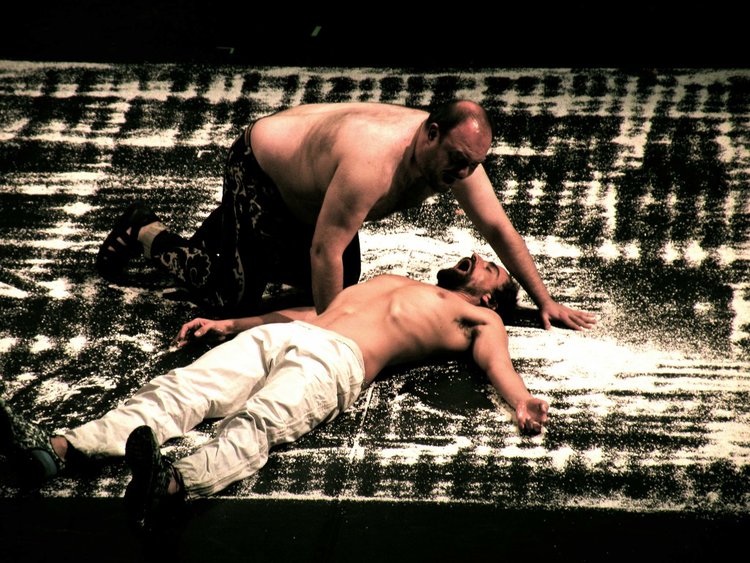
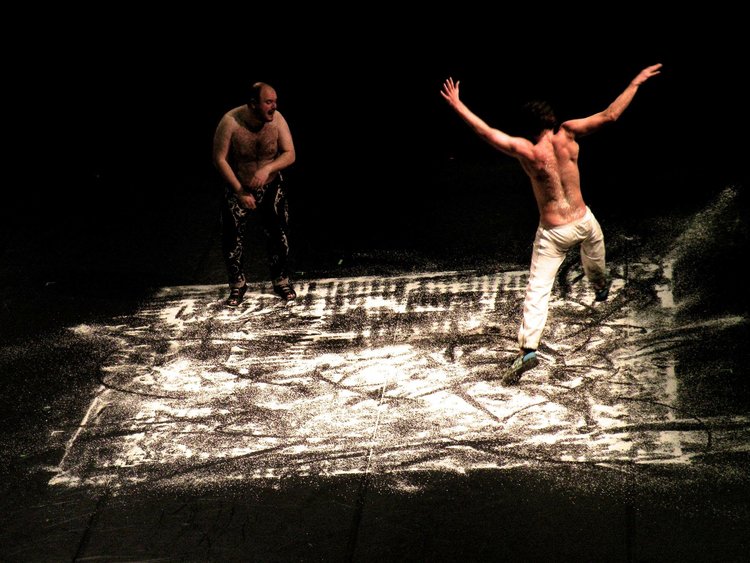

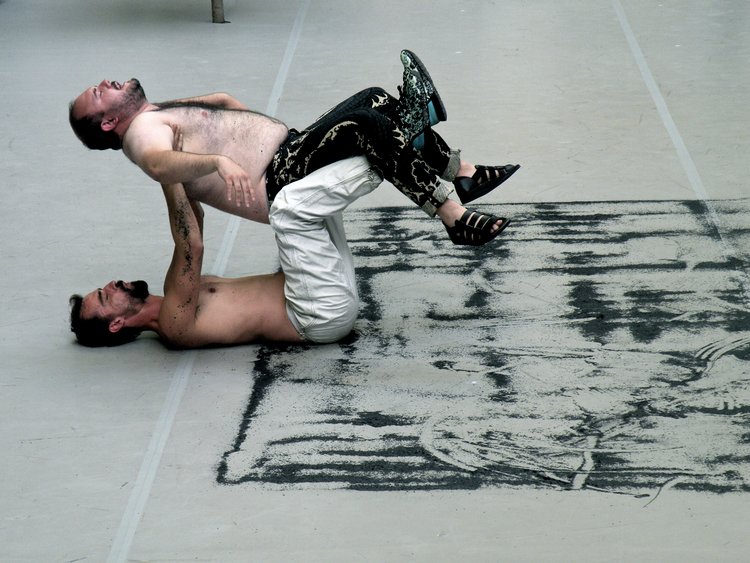
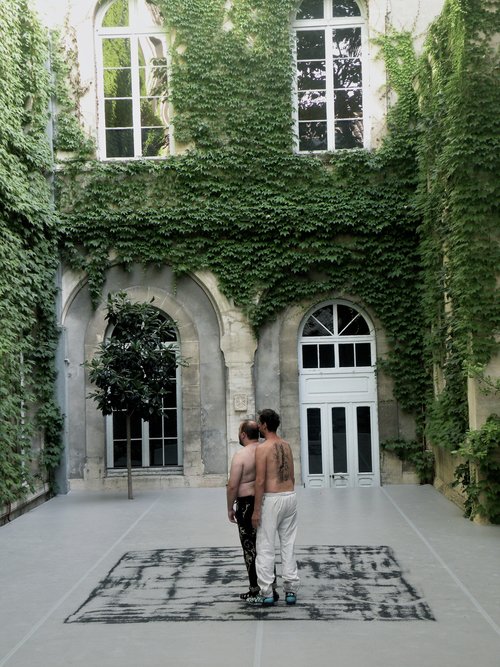
The artists embody “a being with two backs, or better, with two mouths that will not be divided in the process of birth – birth implies an imbalance – but will grow like two cells born from one or like two leaves, which grew from the same bud.” Niño de Elche becomes an instrument for Kejžar and vice versa. “The sensual connection between them is not like cigarette smoke from Genet’s A Song of Love (Un chant d’amour), which travels through the prison wall, but a voice, for which you are not completely aware who it belongs to at the beginning.”
Rave is characterized by a primal scream, which throughout the performance “becomes a scream of confession and develops into a song with no words”, because the two bodies that converse “communicate in something greater than words”, wrote La Parafe’s critic after the premiere. Kejžar and de Elche appeal to existing and future forms of existences beyond the dominant semiologic borders and beyond the dominant ideological verbalization. The artists embody “a being with two backs, or better, with two mouths that will not be divided in the process of birth – birth implies an imbalance – but will grow like two cells born from one or like two leaves, which grew from the same bud.” Niño de Elche becomes an instrument for Kejžar and vice versa. “The sensual connection between them is not like cigarette smoke from Genet’s A Song of Love (Un chant d’amour), which travels through the prison wall, but a voice, for which you are not completely aware who it belongs to at the beginning.”
In the Verbalisation Trilogy, Kejžar, in his unique way, reflects on the ways choreographic norms and dance principles are constructed in order to search for new methods of choreographic staging, synthesizing and in turn deconstructing everything from Judson Church Theater to Jerome Bel and Marten Spangberg. Being methodologically, conceptually and even emotionally committed to radical interrogations of origins of dance, Kejžar, in the trilogy, aims at rethinking traditional rituals and social aspects of dance - as an individual dancer.
Kejžar’s contemporary dance puts the idea of choreography into the everyday social context, while physical virtuosity becomes secondary and even foreign to his work. Kejžar, who nevertheless proved himself to be an extremely virtuoso dancer in the past, especially in the Rosas group, is inspired by Andrew Hewitt’s take on “Social Choreography” as a creation that is comprised of both the dancer’s body in a certain social situation and an obvious tendency of the dancer’s body to transform itself into a collective (spectator’s and dancer’s) sensory experience. According to Kejžar, this social(ised) form of dance and choreography has existed not only in traditional tribal communities, where dance has been predominantly a part of a meaningful ritual, but also in (post) modern forms of dance gathering, such as clubbing, rave, and milonga, which bring about new forms of ritualistic community building. And Kejžar’s Verbalisation Trilogy, as well as his work more generally, is influenced, needless to say, by both of these historical streams. In terms of methodology, Kejžar deals, on the one hand, with deconstruction and re-construction of the technical structure of dance, and, on the other hand, with social and emotional aspects of dance.
In the Trilogy, these socio-emotional aspects (re)create real-life forms of social interaction, while the reworkings of technical structure seem to point to a certain utopian individualism of the future.
In short, the Verbalisation Trilogy appears to draw on SF literature as much as on classic German romantic poetry, while nonetheless putting the corporeality of a human subject in the forefront.
The respective choreographies from the Verbalisation Trilogy should therefore be understood as stemming from a network of various individualizations, resulting in a creation of three distinct interactions between an individual and a community - not only in a theoretical and artistic sense, but also in a practical sense. Through these momentums of moving from the individual position to the common position and vice versa, Kejžar is trying to establish a connection between the idea of dance that is merely reflecting the verbal aspects of communication and the idea of dance as a vocabulary of emancipation, a language of physical liberation that moves beyond the dominant ideological channels of communication, both in the art world and in society in general.
Rave is characterized by a primal scream, which throughout the performance “becomes a scream of confession and develops into a song with no words”, because the two bodies that converse “communicate in something greater than words”, wrote La Parafe’s critic after the premiere. Kejžar and de Elche appeal to existing and future forms of existences beyond the dominant semiologic borders and beyond the dominant ideological verbalization. The artists embody “a being with two backs, or better, with two mouths that will not be divided in the process of birth – birth implies an imbalance – but will grow like two cells born from one or like two leaves, which grew from the same bud.” Niño de Elche becomes an instrument for Kejžar and vice versa. “The sensual connection between them is not like cigarette smoke from Genet’s A Song of Love (Un chant d’amour), which travels through the prison wall, but a voice, for which you are not completely aware who it belongs to at the beginning.”
In the Verbalisation Trilogy, Kejžar, in his unique way, reflects on the ways choreographic norms and dance principles are constructed in order to search for new methods of choreographic staging, synthesizing and in turn deconstructing everything from Judson Church Theater to Jerome Bel and Marten Spangberg. Being methodologically, conceptually and even emotionally committed to radical interrogations of origins of dance, Kejžar, in the trilogy, aims at rethinking traditional rituals and social aspects of dance - as an individual dancer.
Kejžar’s contemporary dance puts the idea of choreography into the everyday social context, while physical virtuosity becomes secondary and even foreign to his work. Kejžar, who nevertheless proved himself to be an extremely virtuoso dancer in the past, especially in the Rosas group, is inspired by Andrew Hewitt’s take on “Social Choreography” as a creation that is comprised of both the dancer’s body in a certain social situation and an obvious tendency of the dancer’s body to transform itself into a collective (spectator’s and dancer’s) sensory experience. According to Kejžar, this social(ised) form of dance and choreography has existed not only in traditional tribal communities, where dance has been predominantly a part of a meaningful ritual, but also in (post) modern forms of dance gathering, such as clubbing, rave, and milonga, which bring about new forms of ritualistic community building. And Kejžar’s Verbalisation Trilogy, as well as his work more generally, is influenced, needless to say, by both of these historical streams. In terms of methodology, Kejžar deals, on the one hand, with deconstruction and re-construction of the technical structure of dance, and, on the other hand, with social and emotional aspects of dance.
In the Trilogy, these socio-emotional aspects (re)create real-life forms of social interaction, while the reworkings of technical structure seem to point to a certain utopian individualism of the future.
In short, the Verbalisation Trilogy appears to draw on SF literature as much as on classic German romantic poetry, while nonetheless putting the corporeality of a human subject in the forefront.
The respective choreographies from the Verbalisation Trilogy should therefore be understood as stemming from a network of various individualizations, resulting in a creation of three distinct interactions between an individual and a community - not only in a theoretical and artistic sense, but also in a practical sense. Through these momentums of moving from the individual position to the common position and vice versa, Kejžar is trying to establish a connection between the idea of dance that is merely reflecting the verbal aspects of communication and the idea of dance as a vocabulary of emancipation, a language of physical liberation that moves beyond the dominant ideological channels of communication, both in the art world and in society in general.





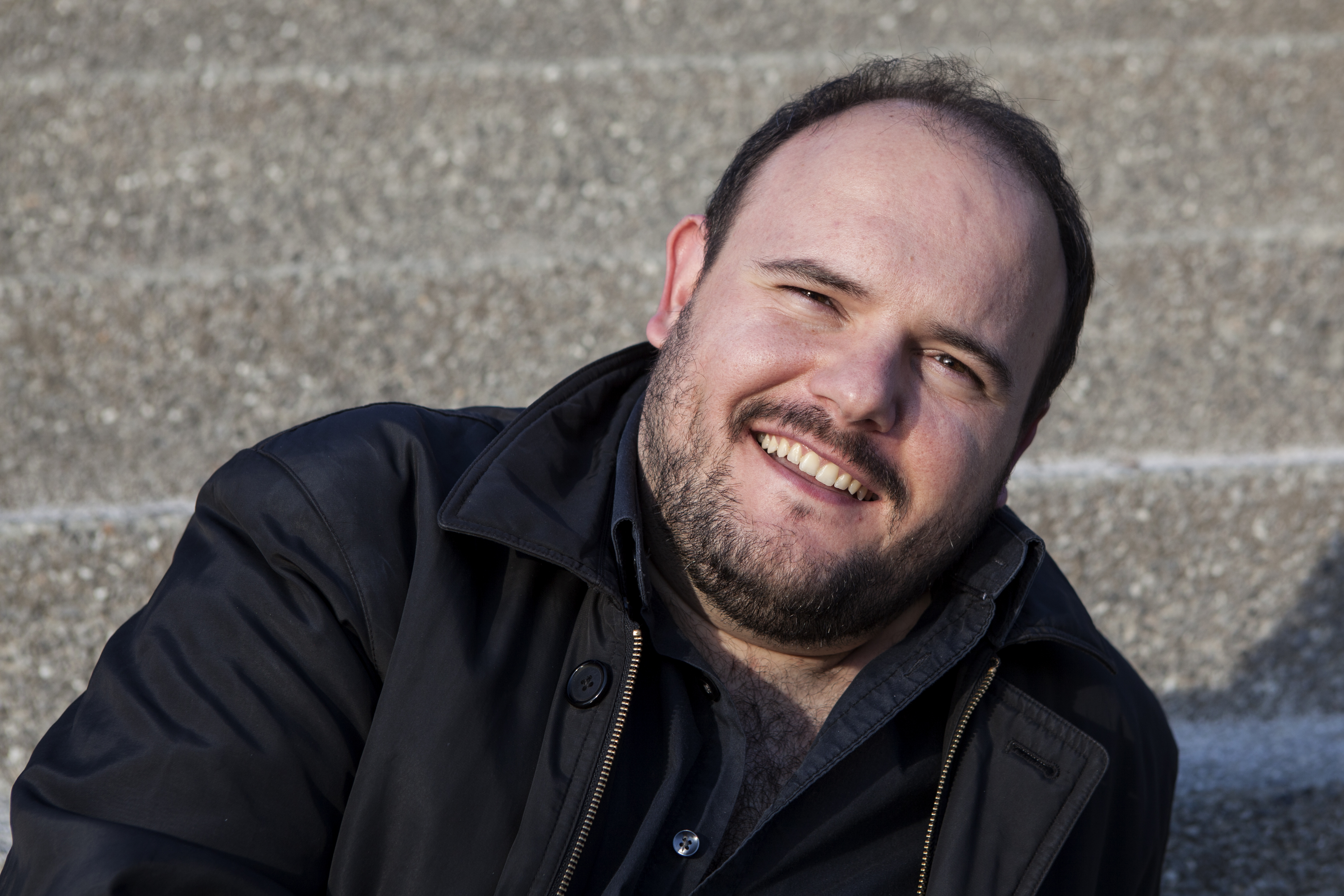
CREDITS
Created by Matej Kejžar
Performed by Matej Kejžar (dance) & Niño de Elche (voice)
Scenography & Light Design: Petra Veber
Producer: Žiga Predan
Produced by Pekinpah
Coproduced by SACD - Festival d’Avignon
2015
Created by Matej Kejžar
Performed by Matej Kejžar (dance) & Niño de Elche (voice)
Scenography & Light Design: Petra Veber
Producer: Žiga Predan
Produced by Pekinpah
Coproduced by SACD - Festival d’Avignon
2015